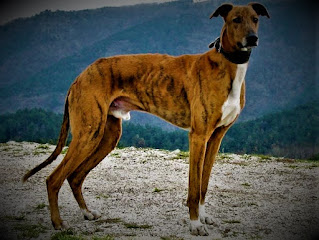Hungarian Greyhound Dog Breed
history
The Hungarian Greyhound is an ancient breed that has been
found in Trans-Sylvania for centuries, grown by the Magyars. Initially, there
were at least two versions of these dogs - for commoners, and for nobility. The
variety, which was found in ordinary people, was usually called farm agar. It
was smaller in size, often used as a universal dog, as well as as a hunter of
small game, especially - hares.
Unfortunately, today the smaller varieties of the Hungarian
greyhound are completely extinct. Nobles used their dogs only in two directions
- first, for hunting, and secondly - for races to the distance. When the
nobleman was going hunting, the dog could run with him 50 or more kilometers a
day.
The breed Hungarian agar appeared in the Carpathians around
the 10th century, and it is believed that it was imported from the outside.
Mostly, researchers tend to believe that the Magyars brought these dogs with
them when they moved to these areas, however, nothing is known about the
existence of these dogs until the 10th century.
The earliest evidence of the existence of the breed in the
10th century can be found among the archaeological evidence found along the
northern border of Hungary, in the Carpathians. The Hungarian agar is now
recognized by various international cytological organizations.
Characteristics
of the breed
popularity 01/10
training 07/10
size 07/10
mind 08/10
protection 08/10
Relationships with
children 10/10
Dexterity 10/10
Breed information
|
country |
Hungary |
|
lifetime |
12-14 years old |
|
height |
Males: 60-70 |
|
weight |
Males: 65-70 |
|
Longwool |
Short |
|
Color |
any |
description
The Hungarian greyhound has a lean, athletic physique,
pronounced chest, and abdominal cavity. The limbs are longer than the middle,
the neck is long, the snout is elongated, and the ears are hanging. The tail is long;
the hair is short.
personality
The Hungarian Greyhound is a positive and friendly breed in
all respects. These animals almost never show aggression to humans, but only if
this very person does not show aggression to the owners of the dog. It should
be remembered that the Hungarian agar has much stronger protective instincts
than other greyhounds, and these instincts can be turned on without warning if
there is a danger to his family.
However, as a watchdog, Hungarian agar is almost never used,
in part because he has to spend most of his time with his family. This is very
important for the harmonious development and existence of the dog, as this
breed needs close contact with its owners. In terms of conditions of detention,
the breed is unpretentious, and can live in a city apartment, and in a private
house.
In a relationship with his family, the Hungarian greyhound
shows great devotion and love, gets along well with children and can live with a
cat or other dog. However, cats should be introduced to them at a very early
age. Hunting instincts are very strong because on a walk, or in the park, as
well as in the forest, the dog can try to chase everything that seems to be her
prey. Including - sometimes even small dogs.
These pets have a very high level of energy, so they need a
lot of exercise, long walks, and running. They don't tend to bark too much. Need
early socialization to make the character less shy and more open. In relation
to stranger Magyar agar behaves with restraint, but without aggression or
rejection.
They treat children beautifully like to spend time with
them in various entertainments, games. In fact, these dogs during the day can
behave quite calmly, and can even sleep during the day, however, it is a purely
feature of the body of greyhounds. If they do not get the daily exercise in the
proper amount, their character will deteriorate, may become depressive, or, on the
contrary, destructive.
Common diseases
The breed of Hungarian greyhound has no complex diseases or
genetic abnormalities.







.jpg)
.jpg)
0 Comments